Allison Bruning's Blog, page 14
May 5, 2015
Ohio's Archaic Heritage: Archaic Settlements #NativeAmerica #Ohio
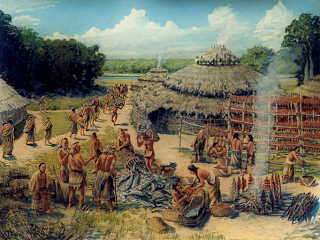 An Archaic Village
An Archaic Villagehttp://ancientlights.org/stoneworks.html
Ohio's Archaic Heritage
Archaic Settlements
Welcome back to Ohio's Prehistoric Heritage. What a journey we had endured so far. We began our walk through Prehistoric Ohio with the arrival of the Paleoindians. We learned that the Native Americans first dwelt in Southern Ohio because they could not go further north. Most of Ohio had been covered in glaciers. Once the glaciers retreated back into Canada, the prehistoric Native Americans began to explore the newly transformed Ohio. Mankind had to adapt when the mammoths and other large mammals went extinct. They developed new hunting techniques and weapons that granted them more freedom. These changes began at the start of the Archaic Period. Eventually the Paleoindians disappeared and the Archaic Culture thrived. The lifestyle changes did not happen overnight but had taken several decades for the new to replace the old.
Archaic Ohio
Although the Archaic Native Americans were highly mobile they did establish settlements. Each of the settlements are completely diverse based on the local resources. Ohio, during the Archaic Period, had four different geographic areas that each presented the prehistoric man with a wide range of diverse resources. These areas are seen in this graphic.
 With the transition from mobile to a more sedentary lifestyle, Archaic Native Americans developed their own unique cultures based on the area in which they had settled. Eventually, distinctive regional differences emerged. You can learn more about Archaic Geography of Ohio and Archaic Man at this link http://www.academia.edu/632282/The_Ohio_Archaic_A_Review
With the transition from mobile to a more sedentary lifestyle, Archaic Native Americans developed their own unique cultures based on the area in which they had settled. Eventually, distinctive regional differences emerged. You can learn more about Archaic Geography of Ohio and Archaic Man at this link http://www.academia.edu/632282/The_Ohio_Archaic_A_ReviewVillages and Camps
The Archaic people had two different types of camps that they used, larger villages and smaller hunting camps. Villages were established where there was a large food source. Depending on the region where these camps were established, the food source could be fish or nuts. According to archaeologists, Ohio was home to at least ten different distinct cultures through the Archaic Period. These cultures are identified in the graph below taken from The Ohio Archaic: A Review. The time period of their occupation is given on the left side of the graph while they are arranged underneath the region of Ohio in which they were located.
 Villages generally contained around 150 - 100 people at any given time. It was here that the Archaic people stayed the longest. Life was still nomadic in that family units moved with the seasons. During the winter, families would leave the village in smaller groups to dwell in rock shelters. These rock shelters were used year after year. The best rock shelters were those that were dry and faced the east. Early and Late smaller camps and rock shelters have been found throughout the state. Not everyone left the village during the winter. The elderly and others who could not travel during the winter often stayed behind in the village and ate from the preserved stock of food that had been gathered for them.
Villages generally contained around 150 - 100 people at any given time. It was here that the Archaic people stayed the longest. Life was still nomadic in that family units moved with the seasons. During the winter, families would leave the village in smaller groups to dwell in rock shelters. These rock shelters were used year after year. The best rock shelters were those that were dry and faced the east. Early and Late smaller camps and rock shelters have been found throughout the state. Not everyone left the village during the winter. The elderly and others who could not travel during the winter often stayed behind in the village and ate from the preserved stock of food that had been gathered for them.During the Spring, the family units would gather once again in the village. It was here they would supplement their diets with fish, berries, plants and nuts. Fishing required a team effort as the Archaic people used nets, spears, hooks on a line, and perhaps even poison to catch a large number of fish. Spring was the perfect season for the Archaic people to fish in because many types of fish swam up river in order to spawn.
Annual Spring gatherings were a joyous time in the village. Many social and ceremonial gatherings took place in the village.
Published on May 05, 2015 06:52
May 4, 2015
LTW: Identifying the #Gifted Student

Identifying the Gifted Student Welcome back to Lightening the Way: Teaching the Gifted Child. This week we will be looking at the qualifications of how to identify a student who is gifted.
 Gifted education has traditionally been reserved for students who score a 130 or above IQ. Borland (2009) argued utilizing a standard IQ score as the aptitude for those who are admitted into a gifted program is problematic. A student who scores 129 on an IQ is not considered gifted and thus is denied services they may need in order to survive their academic career whereas the student who has a 130 IQ is admitted to the program. What is the school supposed to do with the child who just barely missed entrance into the gifted program? Sternberg (2002) argues IQ’s should not be the only measurement used to determine eligibility for admittance into a gifted program but one of many bases used for determination.
Gifted education has traditionally been reserved for students who score a 130 or above IQ. Borland (2009) argued utilizing a standard IQ score as the aptitude for those who are admitted into a gifted program is problematic. A student who scores 129 on an IQ is not considered gifted and thus is denied services they may need in order to survive their academic career whereas the student who has a 130 IQ is admitted to the program. What is the school supposed to do with the child who just barely missed entrance into the gifted program? Sternberg (2002) argues IQ’s should not be the only measurement used to determine eligibility for admittance into a gifted program but one of many bases used for determination.
Intelligence Multiple Intelligences The definition of intelligence has been defined and redefined throughout the centuries. Lunenburg & Lunenburg (2014) found scientist and educators tend to disagree whether intelligence is a single characteristic or a group of different abilities. Harvard professor, Howard Gardner, argued intelligence can be defined by 1) the ability to create a service or product that is valued by the culture in which the creator lives in, 2) a set of problem solving skills that aid someone in solving every day problems and 3) gathering new knowledge and creating finding or creating solutions for problems (Luneburg & Luneburg). Gardner identified nine different types of intelligences: logical - mathematical, linguistic, spatial, musical, bodily-kinesthetic, interpersonal, intrapersonal, naturalist, and existential (Luneburg & Luneberg). He argues that everyone possesses different strengths and weaknesses in all these areas. Luneburg & Luneburg (2014) argued students who struggle in English/Language Arts (ELA) may be doing so because they are not being taught in their preferred intelligence. The researchers suggest classroom educators need to adjust their delivery method and assignment expectations in order to meet the students’ intellectual needs. Successful Intelligence
Sternberg (2002) defined Successful Intelligence as the ability to utilize one’s strengths and correct one’s weaknesses in order to find success in one’s own culture by contributing to the society through a combination of creative, analytical and practical abilities. Like the Theory of Multiple Intelligences, the Theory of Successful Intelligences argues that there is more than one type of gifted student in the world. Yet unlike Multiple Intelligences, Successful Intelligence identifies only four types of gifted students; analytical, creative, practical, and balanced. Sternberg (2002) found Successful Intelligence explains why some gifted students achieve success on IQ tests while others fail, even though they show signs of giftedness outside a test environment.
 An analytical gifted student is identified as someone who is able to analyze, criticize, judge, compare and contrast. Sternberg (2002) found these types of students oftentimes excel in standardized testing and academic settings. The creative gifted student excels at inventing, discovering, imagination, creating and supposing. Sternberg (2002) argued these students do not do well on conventional tests and but excel in the rapid acquisition of creating new ideas. A practical gifted student is someone who excels at putting ideas into practice. Sternberg (2002) found these gifted students are successful in adapting to any environment and can decipher cultural norms that are not taught or verbalized. A balanced gifted person is identified as someone who does not show an extremity is any of the previous categories but is able to exhibit practical, analytical and creative attributes in a balanced way. Sternberg (2002) argues these gifted individuals know precisely how to use all three attributes accurately when faced with any situation.
Intelligence and Identifying Gifted Students
Admittance into any gifted program is generally determined through the standardized IQ testing. Kaufmann (2012) found 90% of states in the United States use IQ scores as part of their definition of giftedness in students. Borland (2009) found most educators believe only 3 – 5% of the world’s population are gifted and challenges educators to rethink those percentage rates because there may be more gifted people in the world than previous believed. Silverman (2014) argues IQ scores may be depressing the reality of the size of the gifted population. Silverman (2014) found IQ scores are inconsistent from test to test thus making it hard to glean an accurate picture of a person’s true intelligence. Silverman (2014) argues the new IQ tests work well for 90% of the population but are inadequately constructed for the highly gifted or the profoundly retarded student. Sternberg (2009) argues the identification of gifted students should be gleaned from a multiple of tests.
An analytical gifted student is identified as someone who is able to analyze, criticize, judge, compare and contrast. Sternberg (2002) found these types of students oftentimes excel in standardized testing and academic settings. The creative gifted student excels at inventing, discovering, imagination, creating and supposing. Sternberg (2002) argued these students do not do well on conventional tests and but excel in the rapid acquisition of creating new ideas. A practical gifted student is someone who excels at putting ideas into practice. Sternberg (2002) found these gifted students are successful in adapting to any environment and can decipher cultural norms that are not taught or verbalized. A balanced gifted person is identified as someone who does not show an extremity is any of the previous categories but is able to exhibit practical, analytical and creative attributes in a balanced way. Sternberg (2002) argues these gifted individuals know precisely how to use all three attributes accurately when faced with any situation.
Intelligence and Identifying Gifted Students
Admittance into any gifted program is generally determined through the standardized IQ testing. Kaufmann (2012) found 90% of states in the United States use IQ scores as part of their definition of giftedness in students. Borland (2009) found most educators believe only 3 – 5% of the world’s population are gifted and challenges educators to rethink those percentage rates because there may be more gifted people in the world than previous believed. Silverman (2014) argues IQ scores may be depressing the reality of the size of the gifted population. Silverman (2014) found IQ scores are inconsistent from test to test thus making it hard to glean an accurate picture of a person’s true intelligence. Silverman (2014) argues the new IQ tests work well for 90% of the population but are inadequately constructed for the highly gifted or the profoundly retarded student. Sternberg (2009) argues the identification of gifted students should be gleaned from a multiple of tests.
Creative Problem Solving The National Research Center on the Gifted and the Talented (2002) found most research conducted on creative problem solving and the gifted population has been conducted on adults instead of children. It is difficult to review literature on this area in gifted education due to the lack of research.

Cho & Lin (2011) found middle school aged children best exhibit creative problem solving skills when faced with ill defined or open-ended problems. Measuring a student’s ability to utilize creative problem solving skills can be problematic. The National Research Center on Gifted and Talented (2002) found, like the Theory of Multiple Intelligences, creativity is expressed differently from person to person and culture to culture. Thus it is difficult to establish a baseline from which every creative problem-solving test administered can be judged against. Cho & Lin (2011) found when psychometric instruments are used to measure creative problem solving skills it usually only measures divergent thinking. Divergent thinking is just one of many different types of creative problem solving skills. Kaufman (2012) found 54% of states in the United States who have defined giftedness have accounted for creativity in their definitions.
Conclusion Defining giftedness through intelligence and/or creativity can be challenging. While in the past an IQ of 130 or above defined giftedness, new research is starting to challenge that practice. The gifted students not only show a higher IQ but also have higher skill sets that were not previously measured. In order to fully understand the gifted student educators, psychologists and administrators need to understand and appreciate all of the advanced skills a gifted student brings to the gifted classroom instead of focusing just on their IQ score.
References Borland, J. H. (2009). Myth 2: The gifted constitute 3% to 5% of the population. moreover, giftedness equals high IQ, which is a stable measure of aptitude: Spinal tap psychometrics in gifted education. The Gifted Child Quarterly, 53(4), 236-238. Retrieved from http://search.proquest.com/docview/21...
Cho, S., & Lin, C-Y. (2011). Influence of family processes, motivation, and beliefs about intelligence on creative problem solving of scientifically talented individuals. Roeper Review, 33(1), 46–58.Hélie, S., & Sun, R. (2010). Incubation, Insight, and Creative Problem Solving: A Unified Theory and a Connectionist Model. Psychological Review,117(3), 994-1024. doi:10.1037/a0019532Kaufman, S. (2012, January). Who is Currently Defined as Gifted in the United States? Retrieved from http://www.creativitypost.com/educati..., F., Lunenberg, M., (2014). Applying Multiple Intelligences in the Classroom: A Fresh Look at Teaching Writing. International Journal of Scholarly Academic Intellectual Diversity, 16(1), 1-13.Silverman, L. K. (2012). Assessment of Gifted Children. Malone Family Foundation. Found at http://www.malonefamilyfoundation.org..., C., & Chia-Yi, L. (2011). Influence of Family Processes, Motivation, and Beliefs About Intelligence on Creative Problem Solving of Scientifically Talented Individuals. Roeper Review, 33(1), 46-58. doi:10.1080/02783193.2011.530206Sternberg, R. J., & Grigorenko, E. L. (2002). The theory of successful intelligence as a basis for gifted education. Gifted Child Quarterly, 46(4), 265-277.The National Research Center on the Gifted and the Talented. (2002). Assessing Creativity: A Guide for Educators (Award No. R206R000001). Retrieved from http://files.eric.ed.gov/fulltext/ED5...
Published on May 04, 2015 03:40
WhatsUpWithAllison: Once a Girl Scout Always a #GirlScout

What's Up with Allison:
Once a Girl Scout Always a Girl Scout
I absolutely LOVE Girl Scouts! I first learned about Girl Scouts in the summer between Kindergarten and First grade. No one in my family had ever been in Girl Scouts before. I was sitting on the front porch of my grandmother's house in downtown Marion, Ohio watching a parade with my mom and my grandparents when I first saw them. A troop of Brownies were marching in the parade. They seemed to be having so much fun. I told my mom I wanted to be just like them. A few weeks after school started my mom enrolled me. I marched in my first parade that year.
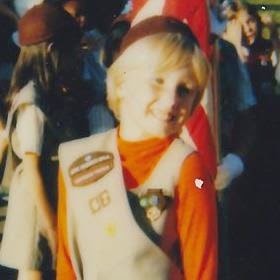
Most girls would drop out of Girl Scouts after their Junior years but I loved the organization so much that I stayed all the way through into adulthood. I went places and did things that I would never have been able to do without Girl Scouts. I even earned the highest award in Girl Scouting - The Gold Award.
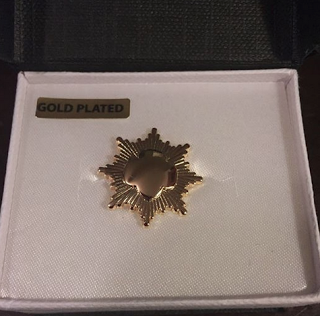
Girl Scouts fostered my love for adventure, camping and exploration. I am the woman I am today because of Girl Scouts. Now it's my turn to give back to Girl Scouts. After I bridged from Senior to Adults I become an assistant leader of a mixed troop of Daisies/Brownies in Alpine, Texas. I learned so much that year on how to run a troop. I took a few years off from being involved in Girl Scouts; except for when I was a camp counselor at Camp Mitre Peak in Alpine, Texas; then got back into it after I married. I was a troop leader for Brownies in Big Spring, Texas for a few years then had to quit because my husband and I had moved. Life happened and now I'm back. This time I have two troops in the Girl Scouts of Central Indiana Girl Scouts Council. My first troop is located on the westside of Indianapolis and is comprised of Daisies/Brownies. My second troop is at Todd Academy, where I am the head of the Elementary Department and the 3rd/4th grade teacher. That troop is comprised of Brownies and a Junior. I periodically combine my troops so they can go on adventures together.
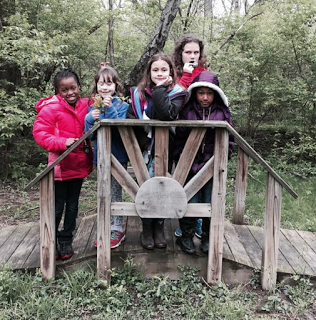
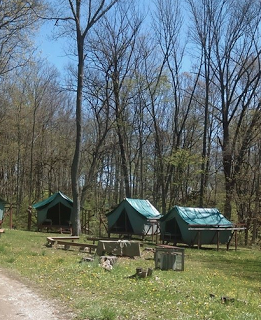
Last weekend I took some of my girls to their first platform tent camping trip. They had had a sleepover the month before. I had signed the girls up for our service unit's camporee at Camp Dellwood. It was supposed to be a beautiful weekend yet when we got there it rained all day long. All my girls were first time campers. Yet, unlike the other troops they stuck it out and continued to camp in the rain. I am SO VERY PROUD OF THEM. The ranger told me we were the only troop that stuck it out in the rain. Even the older girls decided to leave their campsite. The ranger was so impressed with my troops that he invited to take them horseback riding this month. He's been telling everyone at council and his friends how strong my girls are. That's what Girl Scouts are all about. Helping girls become strong, wise young women. Juliette Gordon Low would be so proud of them.
Published on May 04, 2015 03:12
April 22, 2015
To Be #Shawnee: Our Grandfathers - the #Delaware #NativeAmerican #Heritage
 To Be Shawnee:A Bond Between Brothers pt.1Before the white man ever set foot on North America the native inhabitants already had a complex system of trade, government and intertribal relations. The Shawnee were not any different. The Shawnee believed the red man had been spared in Noah's Flood by the Great Spirit (Moneto). All red men were descended by one woman and made the great tribe. This belief influenced the Shawnee and their relations with the other tribes.
To Be Shawnee:A Bond Between Brothers pt.1Before the white man ever set foot on North America the native inhabitants already had a complex system of trade, government and intertribal relations. The Shawnee were not any different. The Shawnee believed the red man had been spared in Noah's Flood by the Great Spirit (Moneto). All red men were descended by one woman and made the great tribe. This belief influenced the Shawnee and their relations with the other tribes.The Shawnee and the Delaware (Lenni Lenape)
Called the grandfathers by the Shawnee people, the Delaware (known as the Lenni Lenape) shared a close bond with the Shawnee. The Shawnee showed this group of people the utmost respect because they believed the Delaware had been the first tribe to be created after the flood.
 "Curiously enough, Our Grandmother did not create the Shawnee first, but they began with the Delaware. When she completed a Delaware man and woman, she put them on the east side of a fire which she had kindled. Then she created one Shawnee division, in the form of an old man and an old woman. After this she created a young man and young woman who were expected to have children who would constitute three of the Shawnee divisions. Here, apparently her interest in creating people ceased..... (Told by Mary Williams, an absentee Shawnee in the book Shawnee by James H. Howard)
"Curiously enough, Our Grandmother did not create the Shawnee first, but they began with the Delaware. When she completed a Delaware man and woman, she put them on the east side of a fire which she had kindled. Then she created one Shawnee division, in the form of an old man and an old woman. After this she created a young man and young woman who were expected to have children who would constitute three of the Shawnee divisions. Here, apparently her interest in creating people ceased..... (Told by Mary Williams, an absentee Shawnee in the book Shawnee by James H. Howard)There is a story that was once told by the Shawnee and Delaware in Pennsylvania of how the Shawnee and Delaware were once one people. The story is known as "The Grasshopper War" and is still told today at Native American PowWows.
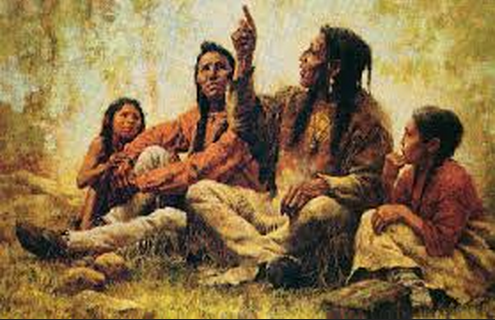 Deep in the Pennsylvania wilderness, before any white man ever set foot on the land, were two villages. The inhabitants of each village liked to visit one another. The men would hunt together and the woman would share their work. Each village enjoyed the company of the other. One day while a boy was visiting he found a grasshopper near a river. He played with his little friend until a group of children came upon them. He showed the grasshopper to his friends and they were all happy playing with the insect together. But one of the boys wasn't happy with the visiting boy's discovery. He thought to himself, "Shouldn't the grasshopper be mine instead of his. This is my village after all." So the upset boy snatched the grasshopper from the visiting boy and ran away with the insect. The children and the boy gave chase. They soon caught up to the thief and the children began to fight, each siding with the boy of their own village. Now the women heard the fight and came out to see what the argument was about. Seeing the blood and bruises of their children they joined in the fight to defend their child and village. The screams grew in the air. Later that day, the men had returned from hunting when they found the females of their family and their children huddled on the ground injured and bloody. The chiefs of both villages wanted vengeance. They declared war upon each other and the men joined their wives and children in battle. After the battle was over, everyone was repulsed by what they had done. A simple argument between boys had led to a battle between friends. Quilt filled their hearts. They decided in order to keep the peace it was best if the two villages went their separate ways. Thus began the Shawnee and Delaware.
Deep in the Pennsylvania wilderness, before any white man ever set foot on the land, were two villages. The inhabitants of each village liked to visit one another. The men would hunt together and the woman would share their work. Each village enjoyed the company of the other. One day while a boy was visiting he found a grasshopper near a river. He played with his little friend until a group of children came upon them. He showed the grasshopper to his friends and they were all happy playing with the insect together. But one of the boys wasn't happy with the visiting boy's discovery. He thought to himself, "Shouldn't the grasshopper be mine instead of his. This is my village after all." So the upset boy snatched the grasshopper from the visiting boy and ran away with the insect. The children and the boy gave chase. They soon caught up to the thief and the children began to fight, each siding with the boy of their own village. Now the women heard the fight and came out to see what the argument was about. Seeing the blood and bruises of their children they joined in the fight to defend their child and village. The screams grew in the air. Later that day, the men had returned from hunting when they found the females of their family and their children huddled on the ground injured and bloody. The chiefs of both villages wanted vengeance. They declared war upon each other and the men joined their wives and children in battle. After the battle was over, everyone was repulsed by what they had done. A simple argument between boys had led to a battle between friends. Quilt filled their hearts. They decided in order to keep the peace it was best if the two villages went their separate ways. Thus began the Shawnee and Delaware.THE DELAWARE
The Delaware originally lived along the Northeast Coast of the Atlantic between the Hudson and Delaware rivers. They were one of the first tribes to come into contact with the white man in the early 1600's.
A loose confederacy of clans, the largest villages at the time of contact had a population of two to three hundred people. Most of the villages, though, only consisted of 25-30 people. Like Shawnee divisions, the Delaware had three major groups. These were" Unalachtigo(Turkey)
Unami(Turtle) and Munsee (Wolf). Each group spoke their own dialect.
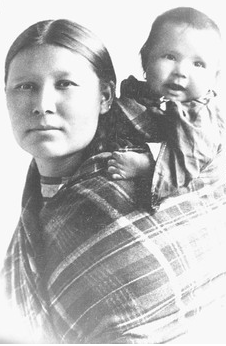
Like the Shawnee, the Delaware also has a clan system. Unlike the Shawnee, the Delaware were matriarchal. A child would inherit their clan identity from their mother. Hereditary leadership passed down from mother to child. If the women elders did not approve of any leader they could remove that leader from their office. Agricultural lands were controlled by the women but the Delaware did not recognize ownership of the the land. Land was collectively owned by whichever clan occupied that area. Unlike the Shawnee, the Delaware did not travel with the season from village to village.Whenever a young woman married the couple would reside with her family so her mother and sisters could help with the family. After she gave birth, the most important person in a child's life was his or her mother's eldest brother. The mother's brother would become the child's mentor and would be from a different clan.
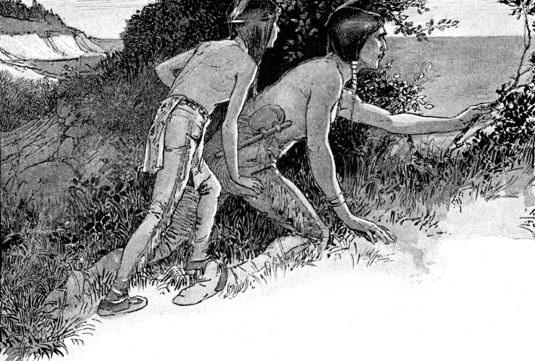
The Shawnee and Delaware enjoyed a friendship from long ago. While the Shawnee were in Pennsylvania, they were closely associated with one another. Like the Shawnee, the Delaware were affected by the outbreak of Smallpox during the 17th century. After the Shawnee left Pennsylvania for Ohio, the Delaware stayed behind briefly. Conflicts with the Europeans and the Iroquois contributed to the Delaware abandoning their homelands. In 1766, through a peace treaty with the British, the Delaware moved west across the Allegheny Mountains into Ohio using Shawnee trails. This pattern would continue until the Delaware were removed by the United States to Oklahoma in the 1860's. The Shawnee would always move first, establish the trails then the Delaware would follow.
The two tribes often joined forces to fight a common enemy together. In 1776, the combined forces of Shawnee and Delaware forced the Cherokee to move deeper into the south. The Shawnee and Delaware fought together in the French and Indian War but not the American Revolutionary War. While the Shawnee were helping the British fight against the newly formed American army, the Delaware were one of the first tribes to sign a peace treaty with the leaders of the future United States. In the treaty, the Delaware promised they would aide the patriots by providing food and supplies. The future United States agreed to grant them a place of importance at the head of the new country in return. Although they fought on opposing sides, the Shawnee and Delaware never lost the close relationship. Even today, the Shawnee honor the Delaware.
Published on April 22, 2015 21:00
April 19, 2015
LTW: #Motivation and the #Gifted Student
 Behavior Problems: I'm Just Not Interested Welcome back to the Lighting the Way: Teaching the Gifted Child. This week we will take a deeper look at the motivational forces that allow gifted children to excel in academics. There are two types of motivation, intrinsic and extrinsic. Intrinsic motivation is the internal drive a person has to do something whereas extrinsic is when a person is motivated to do something because it has external awards or consequences. Everyone has both types of motivation. For example, you want a promotion at work but you need to have a higher degree to do so. So you go back to school to obtain that degree. You were displaying extrinsic motivation to get the degree because you want the promotion at work. Now let's say you decide to go back to school because you want to finish your degree. There's no reason for the degree. You have a great job and a wonderful life. You just feel that there is something missing in your life. You are intrinsically motivated to get the degree because the desire came from within you to do so. Gifted children and adults normally operate out of intrinsic motivation. They have a hunger deep within to learn, create, explore and discover. They also possess the ability to obtain large amounts of information quickly and use that information in meaningful, productive ways that are well beyond their age. One of the reasons our gifted population struggle in American academics is because the teaching methodologies used do not suit the learning style of the gifted students. Once the gifted student deems the academic material is beneath their learning capabilities they will lose interest in the material. If they lose interest then they will find other ways to keep themselves occupied, sometimes at the expense of other students! Academic acceleration works well with gifted students if it is done properly. Gifted students may excel in one subject but not in another. For example, an 8 year old student may be doing 5th grade Math but can't read past a 3rd grade level. So what is the best course of action? Place the child in a 5th grade Math class, 3rd grade Reading class, and remain in 2nd grade for all other academic content. This way the student is being academically challenged. The problem with the American public school system is that most school cannot accommodate the gifted student in this manner. Thus, the student becomes bored and loses interest in school.
Behavior Problems: I'm Just Not Interested Welcome back to the Lighting the Way: Teaching the Gifted Child. This week we will take a deeper look at the motivational forces that allow gifted children to excel in academics. There are two types of motivation, intrinsic and extrinsic. Intrinsic motivation is the internal drive a person has to do something whereas extrinsic is when a person is motivated to do something because it has external awards or consequences. Everyone has both types of motivation. For example, you want a promotion at work but you need to have a higher degree to do so. So you go back to school to obtain that degree. You were displaying extrinsic motivation to get the degree because you want the promotion at work. Now let's say you decide to go back to school because you want to finish your degree. There's no reason for the degree. You have a great job and a wonderful life. You just feel that there is something missing in your life. You are intrinsically motivated to get the degree because the desire came from within you to do so. Gifted children and adults normally operate out of intrinsic motivation. They have a hunger deep within to learn, create, explore and discover. They also possess the ability to obtain large amounts of information quickly and use that information in meaningful, productive ways that are well beyond their age. One of the reasons our gifted population struggle in American academics is because the teaching methodologies used do not suit the learning style of the gifted students. Once the gifted student deems the academic material is beneath their learning capabilities they will lose interest in the material. If they lose interest then they will find other ways to keep themselves occupied, sometimes at the expense of other students! Academic acceleration works well with gifted students if it is done properly. Gifted students may excel in one subject but not in another. For example, an 8 year old student may be doing 5th grade Math but can't read past a 3rd grade level. So what is the best course of action? Place the child in a 5th grade Math class, 3rd grade Reading class, and remain in 2nd grade for all other academic content. This way the student is being academically challenged. The problem with the American public school system is that most school cannot accommodate the gifted student in this manner. Thus, the student becomes bored and loses interest in school.
Published on April 19, 2015 21:00
What's Up With Allison: The Return of Calico and Chief Little Owl

What's Up with Allison?The Return of Calico and Chief Little OwlIt's been a very crazy past couple of months for me. Just as I was getting back to writing on my blog life happened and the flu. I am back to action now. Besides working on my papers for school and teaching I am currently working on the second book of the Children of the Shawnee series. The first book, Calico, took you deep into the world of the 18th century Shawnee. Lies and Deceit will answer questions as to what happened to Yellow Oak and Squirrel Runner? Remember that little secret Fox Fire told Pierre when Little Owl was recovering from alcohol poisoning? How do the lies that were told even before Calico and Little Owl were born affect their perception of the world? Oh, and did I forget to mention someone important in Calico's life is going to lose her life?But who is it?If you haven't read Calico you can find a copy on Amazon.
Published on April 19, 2015 04:22
January 20, 2015
#ExpressYourself: I'm Infected with the Musical Theatre Bug!

I am so excited!!! I can't wait to write about today's topic.

Last week I was asked to write about a musical or play I have viewed. I LOVE musicals! I was raised in a traditional Appalachian Irish family where music played a large part of our lives. Every grandchild was expected to play an instruments. Trouble was I didn't want to play an instrument. I wanted to sing and dance! I started singing onstage in little plays and in my church choir when I was around 5 or 6 years old. It never failed, every Christmas I would be chosen play a shepard or a wise man. I always wanted to be Mary. Anyways, my mother introduced me to the ballet when I was around 9 years old. I absolutely loved it. I will never forget the time we watched Firebird at the BalletMet Columbus.
Forget the orchestra! I wanted to be just like the ballerina who played her on stage and tell a story through movement. I wanted to perform on a big stage! Lucky for me the BalletMet had a kids club where I could learn ballet steps and meet the ballerina's before the show began. I couldn't get enough of the ballet until I learned about musicals.
A few years later, the Palace Theatre in my hometown of Marion, Ohio was looking for child actors for a musical. I tried out and got the part of playing Mickey Mouse. I was so excited to be performing on a big, live stage. I had made it! I had become just like the ballerina in Firebird! While I was there, everyone talked about the Phantom of the Opera. I had no clue what that was. Then the Phantom of the Opera appeared at one of our dress rehearsals with that famous music.
I fell in love with the music and had to know more. I never saw the play but loved the music. My grandparents has exposed me to the musicals on film such as Oklahoma, Dolly, West Side Story and Sound of Music but I never realized that they could be done on stage as well.
A few years later I fell in love with another musical. Our Girl Scout troop took a trip to the theatre in Columbus to see Cats! OMG! You mean there are more musicals than Phantom of the Opera? I realized I could mix my love for music, dance, and theatre together.
In 1998, I changed my major in college from history to theatre. It wasn't a shock to some of my friends. I had been involved with the theatre before I officially changed my major. The musical bug had hit me again with the production of Oklahoma.
The following year while I was in a Mad Max version of Hamlet the stage next to us was practicing for Kiss Me Kate. Every night we would hear the chorus practicing. I decided if I could be in the play I would work backstage. I spoke to the director and was allowed to work backstage.
I graduated in 1999 with a BA in Theatre Arts from Sul Ross State University.
Published on January 20, 2015 22:00
#ExpressYourself: New Year's Here I Am

Welcome back the Express Yourself weekly blog tour. I hope your new year has been kind to you so far. Can you believe February is almost here?

Jan 5 - 9: Do you have a New Year's resolution?
No. I use to do New Year's resolutions but then realized I never stick to them so I quit making them.
Jan 12 - 16: What's a musical or play you've viewed?
See the next post for the answer to that question.
Jan 19 - 23: What's your favorite movie you saw in 2014?
This may sound sad but I didn't have a chance to see a movie last year.
My next post will be about something I am VERY passionate about.
Published on January 20, 2015 21:00
January 19, 2015
#Ohio #Native #Americans: Life in Ohio's Pleistocene
Life
in
Ohio's Pleistocene
A few weeks ago I had presented to you a blog posting concerning the first inhabitants of Ohio. These Native Americans were known as Paleoindians. The Paleoindian Period of history lasted between 13,000 -7,000 B.C. The earliest evidence of human occupation in Ohio dates to 13,000 B.C. Ohio's Paleoindian period overlaps with the introduction of the Archaic Native Americans arriving in Ohio around 8,000 B.C. Scientist had hypothesis that the Younger Dryas impact may have eliminated the Paleoindians yet this is still being researched. You can read more about it at http://en.wikipedia.org/wiki/Younger_Dryas_event Whatever the cause may have been for the destruction of the Paleoindians in Ohio there is no archaeological evidence to support their existence in Ohio past 7,000 B.C.
Ohio during the Paleolitic Period was different than the Ohio we know today. Lake Erie and the Ohio
River did not exist before the glaciers came to Ohio. Instead Ohio had one major river, The Teays River. You can learn more about Ohio's Ancient Nile River at http://www.dnr.state.oh.us/parks/magazinehome/magazine/sprsum04/teaysriver/tabid/364/Default.aspx
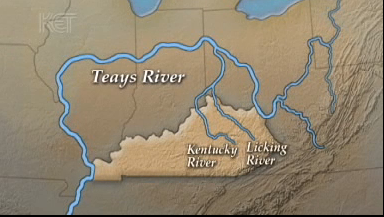 Map of Landscape Before the Paleoindian Period
Map of Landscape Before the Paleoindian Period
KET Television
http://www.teachersdomain.org/asset/k...
This video is from the Kentucky Educational Television and shows how the glaciers formed the Ohio River. http://www.teachersdomain.org/asset/ket08_vid_ohioriver/
Thirteen thousand years ago, the northern part of the state was completely covered by a glacier. Only 1/3 of the state was free from ice. It was very cold and moist. This slowly began to change as the glaciers retreated. The glaciers formed the Great Lakes.
Between 10,000 to 9,000 B.C, the northwestern portion of Ohio was covered by clumps of dwarf willow growing along the river banks. There were many small groves of spruce, pine, aspen, and fir trees separated by open ground. Mastodons, mammoths, elk, caribou, deer, giant beaver and caribou lived in this region. The Paleoindian hunters would often hunt in this region in order to provide for their families. Although several prehistoric animals and Paleoindian points have been found throughout Ohio there has never been a Paleoindian point found with the remains of the animals dated to the Paleoindian Period. The Paleoindians favored hunting Caribou and possibly hunted them using the same methodology that current Eskimo groups in Alaska use today. If we study the Eskimos and their hunting methods we may have a glimpse into how the Paleoindians hunted in Ohio so long ago. You can learn more about the Paleoindian hunting patterns here http://ohsweb.ohiohistory.org/gallery2/main.php?g2_itemId=1200
Ohio's Paleoindians may have been living in the southeastern portion of Ohio as early as 17,000 B.C. The land above the Southeastern portion of Ohio was slowly exposed as the glaciers retreated throughout the Paleoindian Period. The Ohio River and the Great Lakes never existed before the glaciers came. The Paleoindians lived during a time where the land was being slowly and dramatically changed. Paleoindians had to live on the high ground or in caves in order to avoid the flooded valleys that the glaciers left behind as they retreated. Southeastren Ohio was a safe place for the Paleoindians to live since it had not been exposed to glaciers. Here the land was covered with oak, walnut, and hickory trees along the hillsides. The nuts were gathered by the Paleoindians and used as a supplement to their diets.
Although archeologists have never found the skeletal remains of a Paleoindian they can hypothesis what their life may have been like through archaeological records. The Ohio Paleoindians used flint that they found in river beds to make their points. Archeologists have found Paleoindian quarries and workshops along the Walhonding River in Coshocton County.
You can learn more about Ohio's Paleoindians at
http://ohsweb.ohiohistory.org/gallery2/main.php?g2_itemId=40&g2_page=2
A few weeks ago I had presented to you a blog posting concerning the first inhabitants of Ohio. These Native Americans were known as Paleoindians. The Paleoindian Period of history lasted between 13,000 -7,000 B.C. The earliest evidence of human occupation in Ohio dates to 13,000 B.C. Ohio's Paleoindian period overlaps with the introduction of the Archaic Native Americans arriving in Ohio around 8,000 B.C. Scientist had hypothesis that the Younger Dryas impact may have eliminated the Paleoindians yet this is still being researched. You can read more about it at http://en.wikipedia.org/wiki/Younger_Dryas_event Whatever the cause may have been for the destruction of the Paleoindians in Ohio there is no archaeological evidence to support their existence in Ohio past 7,000 B.C.
Ohio during the Paleolitic Period was different than the Ohio we know today. Lake Erie and the Ohio
River did not exist before the glaciers came to Ohio. Instead Ohio had one major river, The Teays River. You can learn more about Ohio's Ancient Nile River at http://www.dnr.state.oh.us/parks/magazinehome/magazine/sprsum04/teaysriver/tabid/364/Default.aspx
 Map of Landscape Before the Paleoindian Period
Map of Landscape Before the Paleoindian PeriodKET Television
http://www.teachersdomain.org/asset/k...
This video is from the Kentucky Educational Television and shows how the glaciers formed the Ohio River. http://www.teachersdomain.org/asset/ket08_vid_ohioriver/
Thirteen thousand years ago, the northern part of the state was completely covered by a glacier. Only 1/3 of the state was free from ice. It was very cold and moist. This slowly began to change as the glaciers retreated. The glaciers formed the Great Lakes.
Between 10,000 to 9,000 B.C, the northwestern portion of Ohio was covered by clumps of dwarf willow growing along the river banks. There were many small groves of spruce, pine, aspen, and fir trees separated by open ground. Mastodons, mammoths, elk, caribou, deer, giant beaver and caribou lived in this region. The Paleoindian hunters would often hunt in this region in order to provide for their families. Although several prehistoric animals and Paleoindian points have been found throughout Ohio there has never been a Paleoindian point found with the remains of the animals dated to the Paleoindian Period. The Paleoindians favored hunting Caribou and possibly hunted them using the same methodology that current Eskimo groups in Alaska use today. If we study the Eskimos and their hunting methods we may have a glimpse into how the Paleoindians hunted in Ohio so long ago. You can learn more about the Paleoindian hunting patterns here http://ohsweb.ohiohistory.org/gallery2/main.php?g2_itemId=1200
Ohio's Paleoindians may have been living in the southeastern portion of Ohio as early as 17,000 B.C. The land above the Southeastern portion of Ohio was slowly exposed as the glaciers retreated throughout the Paleoindian Period. The Ohio River and the Great Lakes never existed before the glaciers came. The Paleoindians lived during a time where the land was being slowly and dramatically changed. Paleoindians had to live on the high ground or in caves in order to avoid the flooded valleys that the glaciers left behind as they retreated. Southeastren Ohio was a safe place for the Paleoindians to live since it had not been exposed to glaciers. Here the land was covered with oak, walnut, and hickory trees along the hillsides. The nuts were gathered by the Paleoindians and used as a supplement to their diets.
Although archeologists have never found the skeletal remains of a Paleoindian they can hypothesis what their life may have been like through archaeological records. The Ohio Paleoindians used flint that they found in river beds to make their points. Archeologists have found Paleoindian quarries and workshops along the Walhonding River in Coshocton County.
You can learn more about Ohio's Paleoindians at
http://ohsweb.ohiohistory.org/gallery2/main.php?g2_itemId=40&g2_page=2
Published on January 19, 2015 21:00





